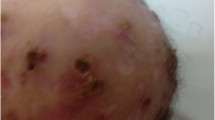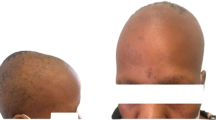Abstract
Syphilis is the most rapidly increasing sexually transmitted disease in the United States. Of those patients who develop secondary syphilis, only about 8% will develop alopecia. Even so, with a rise in case numbers, there will be a concurrent rise in the number of patients presenting with syphilitic alopecia. Alopecia due to syphilis frequently presents as a moth-eaten pattern diffusely across the cranium; however, it has been dubbed the great mimicker due to its presentation taking many forms and copying other causes of alopecia. The pathophysiology behind syphilitic alopecia is thought to be due to a vasculitis in the peribulbar vessels leading to a lymphocytic infiltration and ultimately hair loss. While it is difficult to differentiate from other causes of alopecia, taking a thorough history can help narrow the differential by asking about sexual activity, other known syphilis symptoms, and looking for systemic effects. Infection is generally screened for with Rapid Plasma Reagin (RPR) test and positive screens confirmed using a treponemal test such as Treponema Pallidum Particle Agglutination (TPPA), Fluorescent Treponemal Antibody Absorption test (FTA-ABS) or even Polymerase Chain Reaction (PCR) Currently the best form of treatment is treating the underlying syphilitic infection. Penicillin G 2.4 × 1066 units IM as a one-time dose remains the mainstay treatment of choice. Symptoms of alopecia resolve after successful treatment, typically within 3 months of infection resolution.
Access provided by Autonomous University of Puebla. Download chapter PDF
Similar content being viewed by others
Keywords
A 38-year-old female presented with diffuse hair loss on her scalp, present for about 1 month. She also reported a rash on her face and body that started a few weeks ago. Some of the lesions are scaly and mildly itchy at times. She has tried a topical steroid cream with no improvement. In addition, she admitted to headaches, arthralgias, and fatigue. She reported feeling like she’s had a flu-like illness over the past week.
On physical examination, there were several ill-defined patches of alopecia across the scalp. The eyebrows and eyelashes were of normal density. Her fingernails were normal. She also had diffuse scaly papules and patches on the trunk and face.
What screening test below is likely to diagnose the underlying condition most responsible for her hair loss?
-
1.
HIV
-
2.
RPR
-
3.
CBC
-
4.
TSH
Answer
RPR.
Discussion
Syphilis, caused by the spirochete bacterium treponema pallidum, is the most rapidly increasing sexually transmitted disease in the United States since 2015 with an increase of 74% in infection rate and an increase of 279% in congenital cases [1]. The demographics most impacted by this recent rise are premenopausal women, unborn children, and men who have sex with men (MSM) [2]. Infection is acquired through sexual contact of active lesions, mucous patches, and skin rashes, or through nonsexual sources such as in utero, blood transfusion, and organ transplant from infected patients [3]. T. pallidum rapidly invades microabrasions and mucous membranes traveling to the lymph and ultimately the blood within hours of contact [3]. The spirochetes then rapidly replicate and induce a local inflammatory response in infected tissues resulting in symptomatic presentation [4]. The clinical course is separated into four distinct stages: primary, secondary, latent, or tertiary infection. Each stage has distinct symptoms as well as different courses of treatment.
Early-stage or primary syphilis presents within 10–90 days of exposure most commonly at day 21 [1]. It is marked with a genital chancre; a solitary painless papule that erodes and becomes a hardened ulcer [3]. Resolution of the chancre is common with potential persistent lymphedema [3]. Secondary syphilis is marked by more systemic manifestations around 2–6 weeks post-infection. Common symptoms include a maculopapular rash involving the palms and soles of feet, condylomata lata, general malaise, fatigue, fevers, and alopecia [5]. After the resolution of secondary syphilis, patients either enter latent syphilis or progress to tertiary syphilis. Patients can remain latent and go undetected for 1–46 years; during this stage, they are considered non-infectious but can relapse into secondary syphilis or continue to tertiary syphilis [5]. Tertiary syphilis is marked by various systemic effects; most notably gummas, cardiovascular, and central nervous system involvement [5].
Alopecia due to syphilis is seen in 2.9%–7% of patients with secondary syphilis; however, this is likely an underreported statistic due to a subtle presentation [5, 6]. The non-scarring alopecia can have a pattern that mimics other forms of alopecia (e.g., areata) or can be diffuse, moth-eaten, or a combination of the latter two patterns [7, 8]. Additionally, the hair loss frequently has a predilection for the occipital and parietal regions of the scalp [9]. The mechanism of syphilis causing alopecia is thought to be related to vasculitis of the peribulbar capillaries of the hair follicle, leading to a lymphocytic infiltration with plasma cells preventing hair cycle progression and thus halting growth [10]. While it is difficult to differentiate from other causes of alopecia, taking a thorough history can help narrow the differential by asking about sexual activity, other known syphilis symptoms, and looking for systemic effects [7]. Regardless, physicians should maintain suspicion of syphilitic alopecia in any patient who is currently sexually active and presents with alopecia. Infection is generally screened for with nontreponemal tests such as the Rapid Plasma Reagin (RPR) test. After a positive screen, or if there is continued high suspicion of syphilis, the result is then confirmed using a treponemal test such as Treponema Pallidum Particle Agglutination (TPPA), Fluorescent Treponemal Antibody Absorption test (FTA-ABS) or even Polymerase Chain Reaction (PCR) [11]. Biopsy of the alopecic areas is generally not necessary but if performed, will show a reduction in the number of hair follicles, empty follicles, as well as dilated and tortuous vessels with capillary loss [6].
Treatments
Alopecia due to syphilis is treated by treating the underlying infection; hair regrowth normally occurs around 3 months after treatment [7]. The patient should be treated according to the stage and duration of syphilis infection. Patients experiencing primary, secondary, and early latent disease should be treated with benzathine penicillin G 2.4 × 106 units IM one time [5]. Due to the long generation time of T. pallidum, 30–33 h, long-acting penicillins such as benzathine penicillin G is the preferred therapy to ensure full coverage of infection [4]. If the patient is allergic to penicillin, they may be alternatively treated with doxycycline 100 mg orally twice daily for 14 days or ceftriaxone 1–2 g daily either IM or IV for 10–14 days [12]. Special considerations should be made for pregnant women with a penicillin allergy who should be desensitized and administered penicillin due to teratogenic risks of doxycycline [5]. If a patient is experiencing late latent or tertiary syphilis, treatment should consist of benzathine penicillin G 2.4 × 106 units IM weekly for 3 weeks with the exception of neurosyphilis which requires hospital admission, and IV penicillin G 3–4 × 106 units every 4 h for 10–14 days [12]. Like patients who are pregnant, if a patient with neurosyphilis presents with a penicillin allergy they should be desensitized and utilize penicillin.
Key Points
-
The number of syphilis cases in the U.S. is rapidly increasing; this suggests physicians will be seeing an increase in patients presenting with syphilitic alopecia.
-
Alopecia due to syphilis can present in various forms that mimic other causes of alopecia but suspicion should always be raised with patients presenting with hair loss, particularly with a moth-eaten pattern.
-
The mainstay treatment for syphilitic alopecia is to treat the underlying infection with penicillin and hair regrowth is expected within 3 months post-treatment.
References
Syphilis-CDC Fact Sheet, Centers for Disease Control and Prevention, 8 June 2017, https://www.cdc.gov/std/syphilis/stdfact-syphilis.htm
Schmidt R, et al. Resurgence of syphilis in the United States: an assessment of contributing factors. Infectious Diseases: Research and Treatment. 2019;12:16.
Jameson JL, et al. Harrison's Principles of Internal Medicine. McGraw-Hill Education, 2018. Access Medicine.
Peeling RW, et al. Syphilis. Nat Rev Dis Primers. 2017;3:1. https://doi.org/10.1038/nrdp.2017.73.
O'Byrne P, MacPherson P. Syphilis. BMJ (Clinical research ed). 2019;365:l4159. https://doi.org/10.1136/bmj.l4159.
Bomfim IC, et al. Dermatoscopic findings of syphilitic alopecia. An Bras Dermatol. 2020;95(4):518–20. https://doi.org/10.1016/j.abd.2020.01.007.
Bi MY, et al. Alopecia Syphilitica-report of a patient with secondary syphilis presenting as moth-eaten alopecia and a review of its common mimickers. Dermatol Online J. 2009;15:10. https://doi.org/10.5070/d3390280m2.
Qiao J, Fang H. Moth-eaten alopecia: a sign of secondary syphilis. CMAJ: Canadian Medical Association journal = journal de l'Association medicale canadienne. 2013;185(1):61. https://doi.org/10.1503/cmaj.120229.
Wu MY, Li J. Syphilis presenting with moth-eaten alopecia. Can Med Assoc J. 2021;193:4. https://doi.org/10.1503/cmaj.200894.
Tognetti L, et al. Syphilitic alopecia: uncommon trichoscopic findings. Dermatol Pract Concept. 2017;7(3):55–9. https://doi.org/10.5826/dpc.0703a1.
Syphilis Laboratory Case Definition (LCD). Department of Health, https://www1.health.gov.au/internet/main/publishing.nsf/Content/cda-phln-syphilis.htm.
Sexually Transmitted Diseases Treatment Guidelines, 2015. Centers for Disease Control and Prevention, 5 June 2015, https://www.cdc.gov/mmwr/preview/mmwrhtml/rr6403a1.htm.
Author information
Authors and Affiliations
Editor information
Editors and Affiliations
Rights and permissions
Copyright information
© 2022 The Author(s), under exclusive license to Springer Nature Switzerland AG
About this chapter
Cite this chapter
Kazimir, K., Shehata, A., Sampath, S., Trotter, S.C. (2022). 38-Year-Old Female with Patchy Alopecia Diffusely on the Scalp, Headache, Fatigue, and Rash. In: Trotter, S.C., Sampath, S. (eds) Clinical Cases in Alopecia. Clinical Cases in Dermatology. Springer, Cham. https://doi.org/10.1007/978-3-031-15820-9_22
Download citation
DOI: https://doi.org/10.1007/978-3-031-15820-9_22
Published:
Publisher Name: Springer, Cham
Print ISBN: 978-3-031-15819-3
Online ISBN: 978-3-031-15820-9
eBook Packages: MedicineMedicine (R0)




